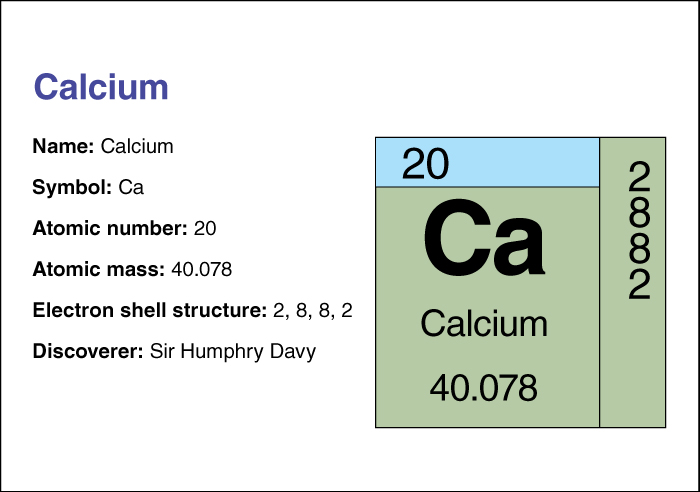Calcium, << KAL see uhm, >> is a soft, silvery-white metallic element found most widely in such rocks as limestone and marble. It is one of the most abundant metals and makes up about 31/2 percent of Earth’s crust. It reacts readily with both oxygen and water. In nature, it occurs only in compounds—chiefly as calcium carbonate, calcium fluoride, and calcium sulfate.

Calcium has an atomic number (number of protons in its nucleus) of 20. Its relative atomic mass is 40.078. An element’s relative atomic mass equals its mass (amount of matter) divided by 1/12 of the mass of carbon 12, the most abundant form of carbon. Calcium’s chemical symbol is Ca. It melts at 839 °C and boils at 1484 °C. It has a density of 1.55 grams per cubic centimeter at 20 °C (see Density). Calcium belongs to the group of elements called alkaline earth metals. For information on the position of calcium on the periodic table, see the article Periodic table.
Calcium and its compounds have many industrial uses. Pure calcium metal, used in certain kinds of alloys, is obtained from molten calcium chloride through a process called electrolysis. Various industrial processes, such as leather tanning and petroleum refining, involve calcium oxide. This compound is prepared by heating calcium carbonate in furnaces called kilns. Calcium fluoride and calcium sulfate are used in making cement and plaster for construction work. Manufacturers use other calcium compounds in a wide variety of products ranging from fertilizer to paint.
Calcium is essential to all living things. It is the most abundant metal in the human body. Calcium is vital for the growth and maintenance of the bones and teeth, and it helps the blood to clot and the muscles to contract. A daily diet that includes green vegetables, milk, and milk products supplies enough calcium for the human body’s normal needs.
Sir Humphry Davy, an English chemist, first isolated pure calcium in 1808. However, the ancient Egyptians, Greeks, and Romans knew about calcium compounds and used them to make mortar, a building material that holds bricks or stones together.
